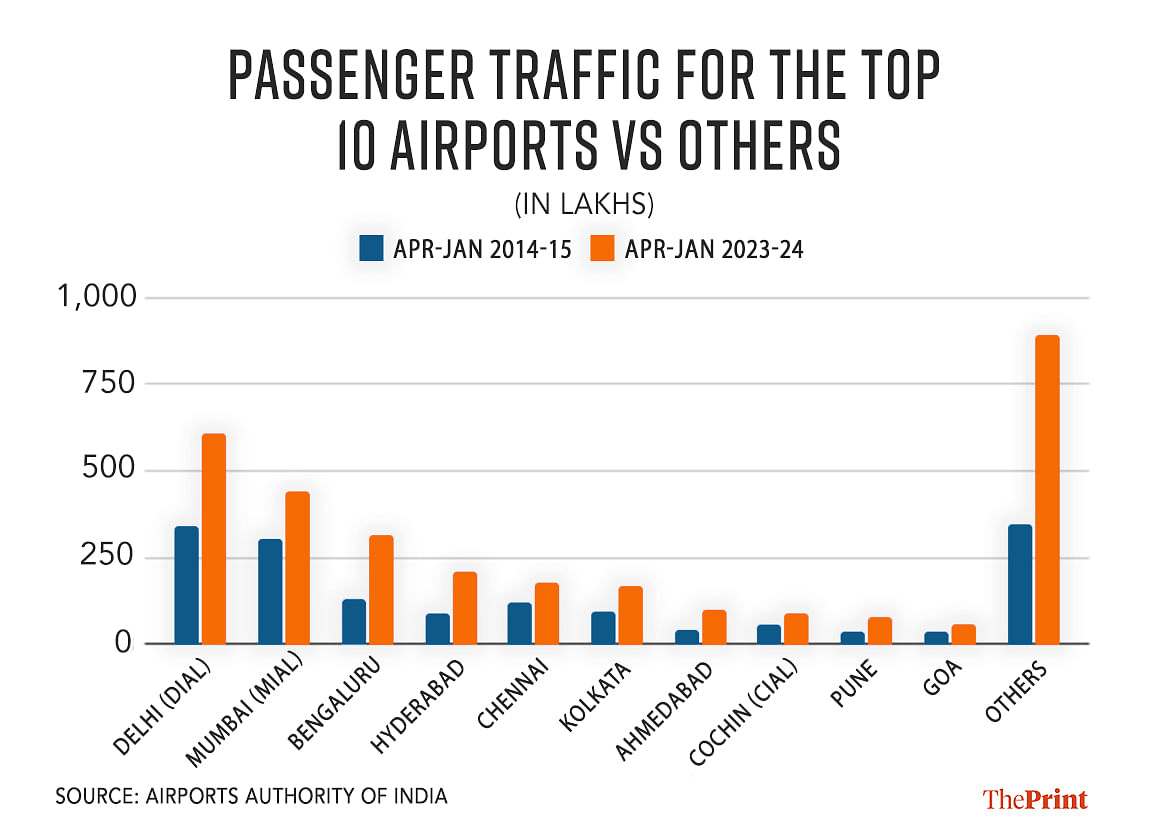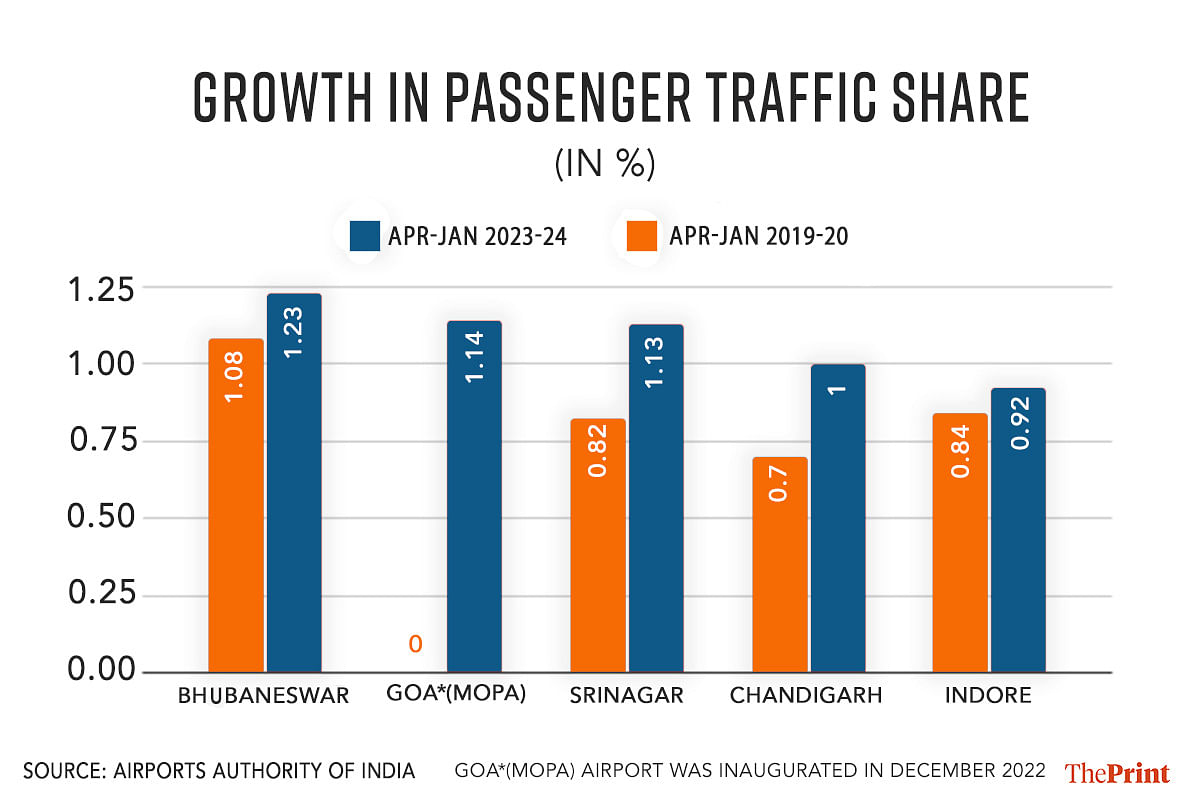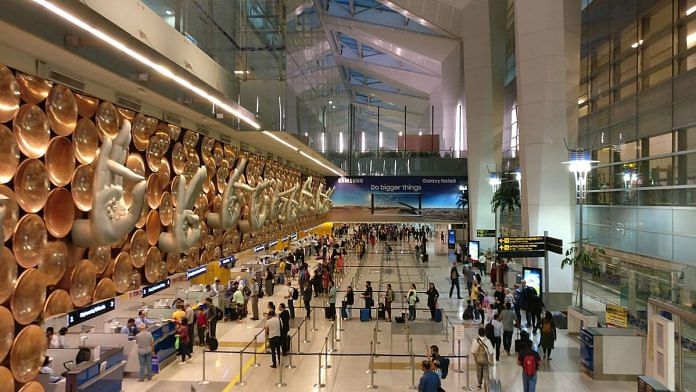New Delhi: In its 2019 election manifesto, the Bharatiya Janata Party (BJP) pledged to double the number of functional airports in the country to over 200 by 2024. However, an analysis of the government data shows the promise remains unfulfilled, with only about 135 functional airports currently operating in India.
However, the party has managed to move closer to its aim of taking air travel to non-metropolitan India.
According to the BJP’s 2019 manifesto, there were 65 functional airports in the country in 2014, which increased to 101 by the end of the first term of the Prime Minister Narendra Modi-led government. “In the next five years, we will double the number of functional airports,” the manifesto stated.
If fulfilled, this would have taken the total number of functional airports to 202, but the data from the Airports Authority of India (AAI) pegs the number of operational airports at 135.
According to the AAI data, in January, there were 135 operational airports in the country, which together handled over 2.25 lakh aircraft movements, 32.73 million passengers and 2.73 lakh tonnes of freight.
A comparison with January 2015 figures reveals substantial growth: back then, airports managed 1,34,620 aircraft movements, catered to 17.11 million passengers, and handled 1.98 lakh tonnes of freight.
Shift in passenger traffic
Interestingly, an analysis of passenger traffic data at airports for the past decade shows a gradual shift away from the top 10 airports.
The contribution of the top 10 airports of the country by passenger traffic — Delhi, Mumbai, Bengaluru, Chennai, Kolkata, Hyderabad, Cochin, Ahmedabad, Pune and Goa — has decreased to 71 percent in April 2023-January 2024 from 78 percent in April 2014-January 2015.

“For a few years now, as the passenger traffic has grown exponentially, major airports have become overcrowded and congested, leading to increased passenger processing times as well as runway congestion,” Shantanu Gangakhedkar, senior consultant, Aerospace & Defense and Frost & Sullivan, told ThePrint.
“Having airports in tier-2 and tier-3 cities aids in easing out congestion at these major airports as passengers who earlier flew through these airports and then took another mode of transport for the last mile are now able to get a direct flight to these locations,” he added.
The contribution of the top five airports — Delhi, Mumbai, Chennai, Hyderabad and Bengaluru — to the country’s passenger traffic at airports, now stands at 54 percent, down from 62 percent in the 10 months of April 2014-January 2015. This is even though these airports have seen a massive increase in passenger traffic.
For example, Bengaluru has seen a 145 percent increase in passenger traffic to 3.12 crore passengers in April 2023-January 2024 from 1.27 crore passengers in April 2014-January 2015.
Similarly, Hyderabad, Ahmedabad and Pune saw a growth of over 100 percent each in the same period. For Kolkata, Delhi, Cochin, Goa, Chennai and Mumbai, the growth was in the range of 45-81 percent.
However, the real story lies in smaller towns. Places like Kanpur, Pantnagar, Gorakhpur, Barapani, and Agra have experienced staggering growth rates — sometimes exceeding 1,000 percent —albeit from a smaller base. Collectively, the smaller airports have significantly increased their share of overall air traffic.
It is important to note that, when looked at individually, each of these smaller airports has only seen marginal increases in their passenger shares. It is only as an aggregate that they make an impact.
This shows that Indians across the country are increasingly taking to the air, and not just in concentrated geographic pockets.
Rise of smaller airports
On aggregate, the airports beyond the 10 largest now account for nearly 30 percent of all passenger traffic — up from about 22 percent in April 2014-January 2015 and 27 percent in April 2019-January 2020.
The other noteworthy point that emerges from the data is that these smaller airports are seeing rapid growth — albeit on a low base — that could further increase their shares if it continues.
For example, Bhubaneswar accounted for 1.23 percent of the entire passenger traffic in the country in 2023-24 — an increase from 1.08 percent five years ago.

However, over the past 10 years, its passenger traffic volume has grown 211 percent to 38.29 lakh passengers.
Similarly, the share of Srinagar airport has grown to 1.13 percent in 2023-24 from 0.82 percent in 2019-20, while Indore’s share grew from 0.84 percent to just 0.92 percent during the same period.
In terms of passenger traffic growth, Srinagar airport saw a growth of 98 percent to 35.20 lakh passengers, while Indore grew 159 percent to 28.65 lakh passengers during this period.
Meanwhile, Goa’s newer airport (MOPA), which was inaugurated by PM Modi in December 2022, has already been able to garner 1.14 percent of the overall passenger traffic in the country.
This, however, comes at the expense of the Goa Dabolim airport, the share of which decreased to 1.83 percent in 2023-24 from 2.42 percent in 2019-20.
Over the past 10 years, several other airports in India have experienced remarkable growth in passenger traffic.
For instance, Kanpur’s Chakeri airport has seen traffic zoom to 2.44 lakh passengers in April 2023-January 2024 from just 1,276 passengers in April 2014-January 2015.
During the same period, traffic in Pantnagar grew by 6,925 percent, while in Gwalior and Gorakhpur it increased by 3,337 percent and 2,579 percent, respectively.
Other cities that saw massive growth include Mysore (1,494 percent), Barapani (Shillong) (1,388 percent), Agra (1,152 percent), Prayagraj (1,033 percent), Surat (775 percent) and Dimapur (500 percent).
Also Read: Darbhanga to Deoghar, small towns are dreaming big with UDAN airports. With some turbulence
‘Major airports to act as hubs’
Despite the growth seen in the smaller airports, aviation expert Gangakhedkar pointed out that the major airports — especially Delhi, Mumbai, and Bengaluru — will continue to act as hubs, which will be crucial in connecting domestic to international routes and international destinations.
He added that these airports aid in bringing economic development to a region as they not only offer passenger connectivity but also faster cargo movement to these locations, especially key for the growing e-commerce segment in the country.
“For a long time, the growth of greenfield and brownfield airports was limited while the passenger demand continued to grow. Now, having these airports is a way of catching up to support the current demand but also for the next 20 to 30 years,” he said, talking about the addition of new airports in the country.
Asked about how many airports would be enough for a vast country like India, he said that along with the size of the country and the density of the population, the number of airports needed also depends on internal connectivity in terms of other modes of transport like roads and trains. The US, for instance, has about 500 airports with scheduled flights.
He added that for the setting up of new airports, the focus should be specifically on the regions that have poor connectivity with major cities.
“Tier-2 and tier-3 cities have not had the best and easiest connectivity in terms of time and distance of travel, and having airports at these locations would help drive the demand,” he said.
The continued passenger demand and ability to pay from these cities also need to be considered, as developing and operating an airport entails high investment and operating costs, Gangakhedkar highlighted.
(Edited by Richa Mishra)
Also Read: 2 clerks, 1 director, 1 room—AIIMS Darbhanga a story of political rush to announce & forget



